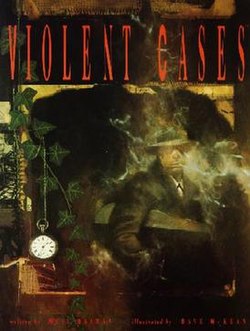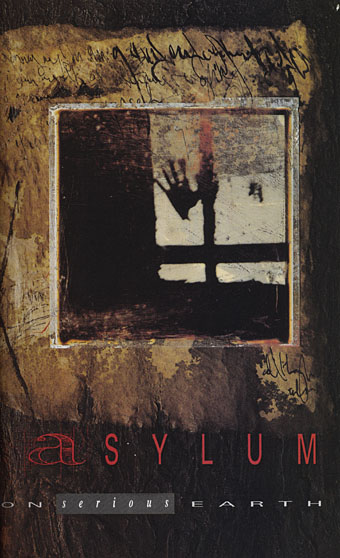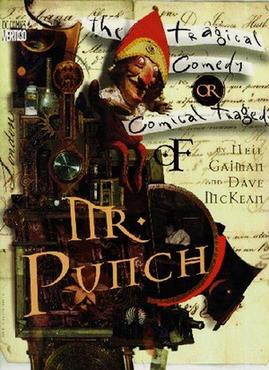So on a bright sunny day, I drove through Rye after a wrong turning and over the River Rother to find a building, recently christened Rye Creative Centre, and the venue of a talk by Dave McKean. In the auditorium. Dave was just finishing the connecting his Mac to the projector and then he walked to the grand piano in the corner of the room and started to play. Admittedly I am not too good with recognising some tunes, but I did note that he played Take Five by Dave Brubeck. He then returned to the stage and joked that he did was impersonating Philip Glass, but not a good impersonation., This is the second time I have seen Dave play the piano before a talk and I think it helps to put both the audience and the speaker at ease and possibly more receptive.
Not from Rye, but from Soho, and used for illustrative purposes (Youtube/Garramedia)
After a brief introduction to Dave, by the one of the people from Rye Creative Centre, he started to say that he didn't really know the audience, as they weren't his usual crowds - so he had "packed everything as you don't always know what the weather will be like on your holidays" or words to that effect. He said that he was going to start with his newer stuff and then go back on his past 25 years. So I shall try to emulate that below, enjoy the journey. I have tried to stick to the talk but I have added some useful links.
Recent and Future Projects
- An Ape's Progress
- This was piece commissioned by The Manchester Jazz and Literary Festivals
- Matthew Sweeney - started with The Old Monkey poem
 |
| Dave McKean (source) |
- Based around Hogarth's Rake's Progress - An Immigrant's Adventures in Manchester
- Puppet made by his wife, Clare,
- Wolf's Child or Callisto and the Wolves
- A project from the Wildworks Group (Bill Mitchell), tells of a story about how a girl from a female orientated society ran to the woods, was seduced by a satyr/centaur, protected by wolves and gave birth to a child - this is only the start of the problems.
- The trailer is seen here.
- Set at Felbrigg Hall
 |
| The White Ladies (Wolf's Child) - (source) |
- Grow the show, let the show create itself, a dark fairy story (with fairy story colours - black, red and white).
- Every night, they took 250 people on a 2 mile hike in the woods
- Animal nature within us and so it may be a book (film)
- Pholk
- Folk Festivals
- Images based on people at Sussex and Kent festivals are less like the ones in Berkshire, people hit each other with metal poles and have stained faces.
- Aren't we all members of different tribes?
 |
| (Dave McKean - source) |
- Wolf's Child film
- Dave filmed each performance, I think with a Canon EOS 5D (but I could be very wrong), and from various angles including a drone octocopter to get shots from the air - the noise from this drone was talked about at one of the after show talks at Wolf's Child by the Matriarch actress. He is slowly piecing this pieces of art together to form a new film
- This story is to follow a pregnant girl who runs away from home and somehow gets invited to the show and finds something at the show.
- Neon/Moth
- Dave has been playing with hardware and software associated with virtual reality, Oculus Rift, with goggles and earphones - he was able to fly and draw, by pinching the thumb and forefinger together to create a stylus. Once drawn, he explained how he was able to move within the drawn form. He was very excited by this. The use for artistic self expression, he said, was boundless. A great exploratory space.
- Dave talks briefly about Neon Moth in an interview in the Century Guild Book One.
- Nitrate
- Posters of Silent Movies
- Dave loves the grammar of film and how it changes in front of your eyes.
- Murneau, George Méliès, F. W. Murnau's Faust, The Student of Prague by Henrik Galeen to name but a few.
 |
| Dave McKean (source) - this image is at the exhibition in the Rye Creative Centre (until 30/10/2015) |
- He has contributed to two books for the Century Guild Gallery (A Nitrate and Kinogeists Preview Catalog & Nitrate & Kinogeists 2 Teil Silent Cinema Art Catalog). The gallery's blog gives you a bit more about Dave's work and how the relationship between he and gallery continued.
- Dave has also played with the images for Dali's Un Chien Andalou, he loves how audiences wince at the eye slicing part. He also plays with The Cabinet of Dr. Caligari and M (he cites this as a honorary "silent" movie).
 |
| Dave McKean (source) |
- Caligaro
- This is a relatively new comic project, Dave tells of how being ill when he was a young child and he got into reading through comics. This comic project is based on the film of The Cabinet of Dr. Caligari (1920) - an anarchic script with a sleeping man. A new ending and beginning were added by Robert Wiene that changed the anarchic tones.
- Dave's project has changed the ending, but he wouldn't tell us (luckily) and he has set it around Rye. So beware if you upset him in one of Rye's tea rooms, you may end up dead in a page.
- Berkshire College of Design
- Learnt about semiotics, signs and signifiers of film.
- Got paid to do professional work in the evening after a day in the college.
- Dr. John Leo DeFreitas used to do a talk on everything and Dave loved his enthusiasm, DeFreitas helped curate the art show of Dave's work - Graphicus.
- A video, by Maria Cabardo, where Dave talks of his at college can be seen here.
- Nothing was mentioned of Meanwhile.
- He met up with Neil Gaiman in 1986.
- Met with Paul Gravett, with Neil, to create a "comic strip/story" for the magazine, Gravett, to his credit, published it as a 44 page graphic novel, the title was Violent Cases. This one book has seven or eight covers (from my memory). There is a good article on this book at Comic Book Resources.
 |
| Dave McKean (source) |
- Arkham Asylum (1989)
- As Dave joins the DC stable of artists, he joins writer Grant Morrison to create Arkham Asylum. This was a golden moment, it has become the most successful comic book ever, at that time.
- Dave thinks he may have got the job at DC by Neil being a pushy journalist, but they have been working together for a long time, so something must be working.
 |
| Dave McKean (source - an interesting article by John Coulthart that sources the hand print from a Mario Bava film from Curse of the Dead) |
- Signal to Noise
- Originally commissioned by The Face magazine and then with added pages was published by Gollancz. Paul Gravett talks of it briefly in an article on Dave, see here. Dave didn't say much of it, but showed a couple of images of it.
 |
| Dave McKean (soruce) |
- There is an audio play that was made for the BBC radio network and then it was published both by the BBC and Feral Records.
- On the DVD Keanoshow, there is a Signal to Noise short video sampler, this can be partially seen on the show reel of Christian Krupa, see here, about the 30 seconds mark..
- Mr. Punch
- A story about that mixes real life and mixed memories, similar to Violent Cases, and Dave went through all the characters that get killed (the baby, the policeman, etc.) and then ends by saying it is, as we all guessed, a tale of a serial killer. The story ends on a high note when all the people are killed, Mr. Punch is allowed to spread his cheer around the land.
 |
| Dave McKean (source) |
- Cages
- This is a collection of stories in one long book. There are stories on the nature of belief and creation myths. It is good to see that both the cat and the man as well as the creation myths make a welcome return in Pictures That Tick Volume Two.
- It has memorable characters such as the man with his words, the two removal men, Angel the musician. Great scenes that mirror life such as the joke telling at the Jazz club, that don't mirror life where a man talks with a cat both supported by clouds.
- Dave said that he didn't really like drawing superheroes in odd poses with capes billowing in the wind, but liked adding pauses, real life people.
- After Book or Chapter 3, he got a letter saying that the reader knew what Dave was doing, so with great Dave'ness he add a non sequential part, the girl in the woods section. That stopped the letters, that pleased Dave.
.jpg) |
| Dave McKean (source) |
- Time published an article on Cages, here it is.
- Covers
- Probably how we first heard of Dave's work, he quickly flicked through a few early covers and then a couple of covers from The Sandman Overture.
- Have a look at the book Dream Covers. He did say, at the beginning of the talk that he prefers to talk more about his current projects than his past work. He wrote something similar to this in the recent book Dream States.
- Neil's story of the fish that is shown in Dream States is based upon his trip to the refugee camps.
- Dave like machine more than computers; as computers don't play with you whereas with machines you can press lots of buttons and shine lights in them and then produce something, saying (if they could) "Is this what you wanted?"
- Father's Story
- Creation Myths
- Black Holes
- 40th Birthday
- The Coast Road
- The Rut
- The Blue Tree
- John Cale - What's Welsh for Zen
- Celluloid
- Sex is fun, its okay. Dave doesn't really like violence. So he made a book for your brown paper bag. One person did bring a copy to sign and Dave did mention the aforementioned bag. There is a video of some of the pages from the book on this Fantagraphics page. Century Guild does a review of the book here.
- Smoke & Mirrors
- Illustrations
- Exhibitions
- Rye Art Gallery - a few images were shown at The Blue Tree Exhibition, including one of the stag and the photographer.
- Heston Blumenthal work
- The Fat Duck Cook Book
- Historic Heston
- Restaurant Murals
- Website
- Restaurant Based Art Work
- Short Stories
- Bob Dylan
- Desolation Row
- Mojo Magazine illustration 2015
- Iain Sinclair
- London Orbital
- Book Covers
- Talk at The Horse Hospital, 2014
- A Clockwork Orange
- Comics Unmasked
- Podcast by Alex Fitch
- Terror & Wonder
- The poster
- The art of gothic album covers
- Record/CD Covers
- Counting Crows
- Dreamtheatre
- Buckethead
- Michael Nyman
- John Cale
- Frontline Assembly
- Black Waterside
- Feral
- Feral Records
- Monographs
- A Book of Black and White Lies
- Option Click
- The Particle Tarot Major
- The Particle Tarot Minor
- Sketchbook Series
- Cities
- Squink
- Children's Books
- Goldfish
- Wolves
- Crazy Hair
- Coraline
- Graveyard Book
- Homecoming and Ray Bradbury
- David Almond
- The Savage
- Slog's Dad
- Mouse, Bird, Snake, Wolf
- S.F. Said
- Varjak Paw
- Varjak Paw, the Outlaw
- Phoenix
- Dawkins
- Harry Potter
- Films
- The Week Before
- Neon
- Displacements
- Whack!
- Mirrormask
- Gospel of Us
- Luna
- 9 Lives
- Questions answered at the end
- Drawer's Block
- Do you dream a lot
- Working with S. F. Said
- Look for things before coming involved in projects
- Awards
- Frequently Asked Questions
- Have a look at the FAQ on Dave's website.
- Biography
- Have a look at his biography on his website.
 |
| Dave McKean (source) |
| Dave McKean (source) |

























